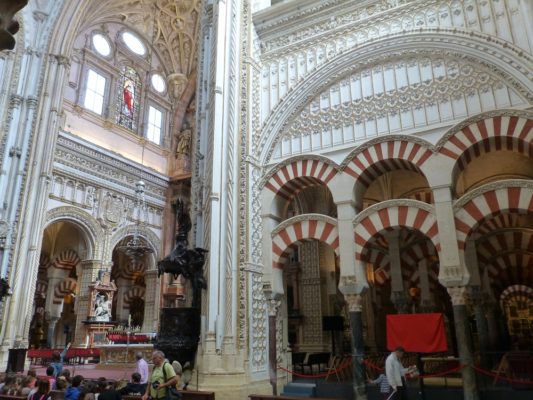Architecture is about buildings and buildings range from simple dwellings to majestic structures. These larger structures serve as a means of cultural communication in some form or other. Within Spanish architecture, they reflect community values or pursuits of a number of different cultures: e. g. Roman coliseums or theatres, Christian, Muslim, Jewish houses of worship).
Buildings inform us of the movement of people, who take their architectural traditions with them in the form, for example, of temples. Spanish architecture also conveys the impact of political events in, for instance, the construction of castles or palaces.

These buildings -temples, castles, palaces— communicated in different ways the idea of power and control, and were meant to last. Others buildings, e.g. the homes of ordinary citizens were less important, although many have survived in the historical quarters of many cities.
When cultures come together on a large scale, or “clash” (to use Samuel Huntington’s term), there may be considerable social upheaval and displacement.
In Spanish architecture, this was expressed in the buildings that the dominant culture erected, and the geographical area that these buildings covered helped to identify the extent or limitations of their presence or power. Such buildings often bore an identifying sign or design (e.g. the design of a church and mosque are quite different), and as the community grew so the buildings became larger or more impressive in some way, both as a more pronounced declaration of self identity and as territorial markers.
As in other countries, Spanish architecture also reflected internal ideological divisions or regional rivalry. Castles, for example, didn’t always signify a means of defence against a foreign force; they might be built by a ruler to reinforce his control within his own territory. In other instances, castles were a visible expression of the power, wealth or prestige acquired by an individual, in which case they were more likely to be palatial than military in their structure.
Buildings as expressions of power, prestige etc. are still very much with us. Take, for example, skyscrapers, for long associated with the U.S.A. They are architectural metaphors of the rise of that country as a world power. Now other growing world powers (e.g. India, China, Brazil) or countries wishing to be “seen” (e.g. Malaysia, Dubai), are all busy constructing skyscrapers or hugely impressive buildings (e.g. sports stadiums).
[Within this context, the destruction of the Twin Towers in New York on September 11, 2001, was intended to undermine the authority and prestige of the U.S.A. and humiliate Americans, especially as it was carried out by a small group of individuals. It was meant to show, graphically, how the mighty can fall! Ironically, one of the leaders of the attack -Mohammed Atta- was an architect who had written a thesis on modernist architecture in the Syrian city of Aleppo. In the thesis, he suggested that tall buildings were symbols of Western colonisation of the East.]
Of course, buildings do not have to be large to impress. Prestige can also be won with bold, visionary projects on a smaller scale. For example, Bilbao’s Guggenheim Museum catapulted the Basque city into the public sphere making it now a must-see tourist attraction while stimulating other architectural projects in the city at the same time .

The Middle Ages are a particularly exciting period in Spanish architecture because of the meeting of two major cultures: Christian and Muslim (Moorish is the usual term in the Spanish context).

We hope to show how Christian and Moorish architecture reflects their different perspectives of the world or of changing circumstances; this is particularly so in their houses of worship (Romanesque and Gothic cathedrals and churches, and Muslim mosques), palaces and castles. We’ll also explore a very interesting phenomenon in Spanish architecture: Mozarabic and Mudejar architecture, the results of the close proximity in which Christians and Moors lived.
As we move from the Middle Ages, we’ll try to explain how changing political or social factors are reflected in Spanish architecture. For example, what was behind the appearance of Renaissance and baroque buildings in Spain in the 16th and 17th centuries, for example Charles V’s palace in the Alhambra, or the immense Escorial just north of Madrid? And where does that peculiarly Spanish style, Plateresque, fit in?

What was the impact on Spanish architecture of a change of royal dynasty in the 18th century or of Romanticism in the 19th century? Finally, we’ll look at the effects of political instability in the first half of the 20th century on Spanish architecture, then the Franco dictatorship, and finally the resurging vitality of the post-Franco years, with both native-born and foreign architects (e. g. Los Angeles architect Frank Gehry’s Guggenheim Museum in Bilbao) producing stunning architectural works.

